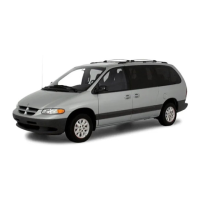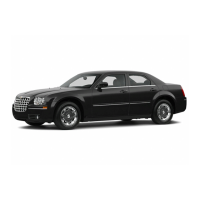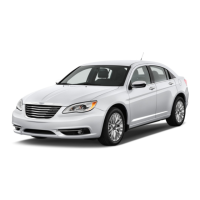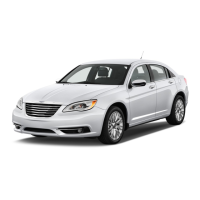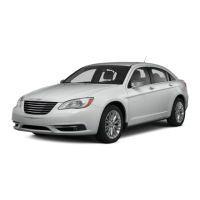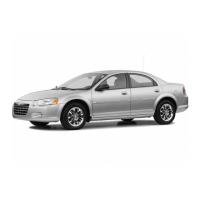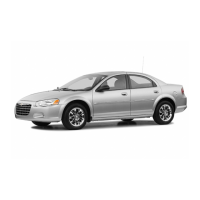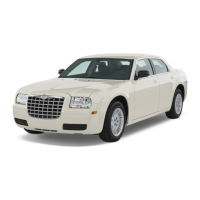other damage to the trailing arm. If the trailing arm
is bent or damaged the trailing arm will require
replacement. Do not attempt to repair or
straighten a trailing arm.
STABILIZER BAR (REAR)
Inspect the stabilizer bar for damage or bending.
Inspect for broken or distorted stabilizer bar bush-
ings, bushing retainers, and worn or damaged stabi-
lizer bar to strut attaching links. Verify all fastener
bolts are properly tightened.
STABILIZER BAR ATTACHING LINKS
Inspect the bushings and sleeves on the stabilizer
bar attaching links for damage or deterioration.
Inspect the lower ball stud for excessive looseness
and damage. Inspect the stabilizer bar attaching link
to ensure it is not bent or broken. If any of these con-
ditions are present when inspecting the attaching
links, replacement of the attaching link is required.
REMOVAL AND INSTALLATION
SERVICE WARNINGS AND CAUTIONS
WARNING: DO NOT REMOVE THE STRUT ASSEM-
BLY’S SHAFT NUT AT ANY TIME UNLESS THE COIL
SPRING HAS BEEN PROPERLY COMPRESSED
FOLLOWING THE PROCEDURE LISTED IN DISAS-
SEMBLY AND ASSEMBLY IN THIS SECTION.
CAUTION: Only frame contact or wheel lift hoisting
equipment can be used on vehicles having a fully
independent rear suspension. Vehicles with inde-
pendent rear suspension can not be hoisted using
equipment designed to lift a vehicle by the rear
axle. If this type of hoisting equipment is used dam-
age to rear suspension components will occur.
NOTE: If a rear suspension component becomes
bent, damaged or fails, no attempt should be made
to straighten or repair it. Always replace with a new
component.
STRUT ASSEMBLY (REAR)
REMOVAL
NOTE: When removing rear strut assembly from
vehicle, access for the 3 rear strut assembly to
strut tower attaching nuts is through the passenger
compartment of the vehicle.
(1) Remove the rear seat cushion from the interior
of the car. Refer to Seats in the Body section of this
manual for the required procedure to be used for this
vehicle.
(2) Remove the rear seat back assembly. Refer to
Seats in the Body section of this manual for the
required procedure to be used for this vehicle.
(3) Remove both upper quarter trim panels from
the rear of the vehicle interior. Refer to Body Compo-
nents in the Body section of this manual for the
required procedure to be used for this vehicle.
(4) Remove both lower quarter trim panels from
the rear of the vehicle interior. Refer to Body Compo-
nents in the Body section of this manual for the
required procedure to be used for this vehicle.
(5) Remove the rear parcel shelf trim panel from
the vehicle interior. Refer to Body Components in the
Body section of this manual for the required proce-
dure to be used for this vehicle.
Remove the 4 screws securing the rear speaker and
mounting plate in place for the side of the vehicle
requiring repair. The speaker should be removed
from the vehicle with the mounting plate
attached Unplug the wiring from the speaker, then
remove the speaker and mounting plate from the
vehicle.
(6) Raise vehicle on jack stands or centered on a
frame contact type hoist. See Hoisting in the Lubri-
cation and Maintenance section of this manual for
the required lifting procedure to be used for this
vehicle.
(7) Remove the rear wheel and tire assembly from
the vehicle.
(8) Remove the rear caliper assembly from the
adapter. Refer to Rear Disc Brakes in Group 5
Brakes of this Service manual for required caliper
removal procedure. After removing the caliper assem-
bly, store the caliper by hanging it from the under-
side of the vehicle (Fig. 4). Do not let the rear caliper
assembly hang from flexible brake hose.
(9) If loose on wheel mounting studs, remove rear
braking disc from hub.
(10) If the vehicle is equipped with antilock
brakes, remove the wheel speed sensor from the disc
brake caliper adapter by removing the bolt, then the
sensor (Fig. 5).
(11) Remove the lateral links from the spindle
(Fig. 6). This requires the removal of one long bolt
attaching both links to the spindle (Fig. 6).
(12) Install a thin wrench on the hex of the stabi-
lizer bar attaching link stud to keep the stud from
turning in the link. Next, remove the nut from the
stabilizer bar attaching link stud at the stabilizer bar
(Fig. 7). Remove the link from the stabilizer bar.
(13) Loosen and fully remove, the rear spindle to
strut assembly pinch bolt (Fig. 8).
2 - 48 SUSPENSION LH
DIAGNOSIS AND TESTING (Continued)
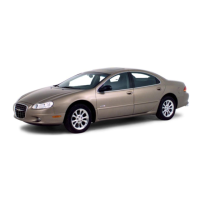
